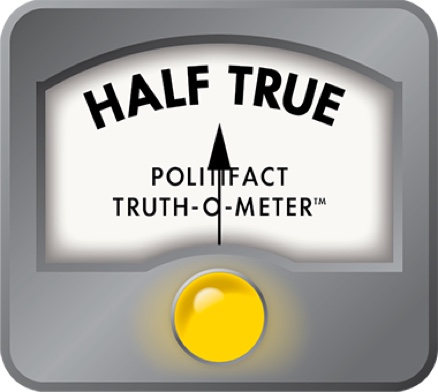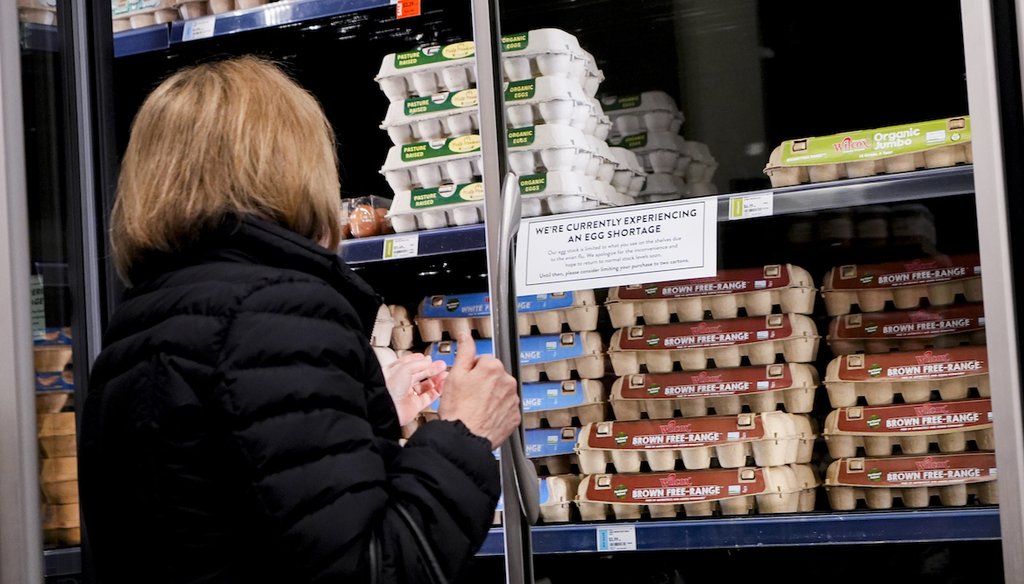

Our only agenda is to publish the truth so you can be an informed participant in democracy.
We need your help.


A shopper browses for eggs Jan. 27, 2025, in front of a sign posted about egg shortages at a PCC Community Markets grocery store in Seattle. (AP)
About 108 million commercial egg-laying chickens have died since a highly pathogenic avian influenza outbreak began in 2022, either from the virus or culling, Agriculture Department data shows.
Depopulation of a farm’s chickens, most of which would die anyway, takes place to prevent the virus’ spread.
Depopulation is not a new strategy unique to former President Joe Biden’s administration. It also was USDA policy during President Donald Trump’s first term.
President Donald Trump promised to lower prices for groceries, including eggs. But one crack in his plan is that egg prices haven’t fallen since he took office Jan. 20.
White House Press Secretary Karoline Leavitt, in her first on-camera press briefing Jan. 28, blamed that on former President Joe Biden’s "inflationary policies."
Leavitt said the Biden administration and the U.S. Agriculture Department "directed the mass killing of more than 100 million chickens, which has led to a lack of chicken supply in this country, therefore a lack of egg supply, which is leading to the shortage."
Leavitt’s statement is partially accurate about the culling of millions of chickens, but she omitted important details and context about why that happened.
First, the chickens were killed to prevent the spread of the highly pathogenic avian influenza, or bird flu.
Second, it’s been long-standing USDA policy to cull an entire flock of birds once bird flu has been detected, including during Trump’s first administration.
White House Deputy Press Secretary Anna Kelly referred PolitiFact back to Leavitt’s press briefing comments.
Egg prices rose under Biden — from $1.60 per dozen in February 2021 to $4.10 in December 2024 (his first and last full months in office), Bureau of Labor Statistics data shows. The Agriculture Department’s January food price outlook said egg prices could rise about 20% more this year.
A spokesperson for Expana, a company that tracks consumer prices, told Axios that a dozen large eggs costs more than $7 in some U.S. regions.
Since Feb. 8, 2022, when the virus was detected in a commercial flock, more than 147 million birds, including chickens, turkeys, ducks and geese, have died, the USDA said.
USDA data shows 108 million egg-laying chickens died since 2022, including 13 million in 2025. It’s not clear how many were euthanized or died of the virus.
As of Jan. 29, bird flu has also been detected in dairy cattle, affecting 944 herds in 16 states, U.S. Centers for Disease Control and Prevention data shows. Humans have also tested positive for the virus — 67 confirmed cases have been reported in the U.S. and one person has died, the CDC said.
Experts told PolitiFact the birds are culled to stop the virus from spreading. This protects not only nearby farms and the poultry industry, but public health. A 2002 federal law, the Animal Health Protection Act, gives the USDA’s Animal and Plant Health Inspection Service authority to depopulate herds and flocks to stop the disease’s spread.
"If the birds are dead, the virus dies along with them," Russ Daly, a veterinarian for the South Dakota Department of Health and a South Dakota State University professor, said.
Chickens that contract the bird flu virus have little chance of survival; 90% to 100% of them die, usually within 48 hours, the CDC said.
Waiting for the chickens to die naturally allows more viral load into the atmosphere, making it more dangerous for the farm workers and other people who come in contact with the farm, Jada Thompson, a University of Arkansas agricultural economics and agribusiness associate professor, said.
Several veterinary professors told PolitiFact that depopulation or "stamping out" of sick birds is a long-standing policy and pointed to a 2015 bird flu outbreak during the Obama administration.
Depopulation is the USDA’s primary control and eradication strategy for avian influenza, Yuko Sato, a veterinarian and Iowa State University associate professor, said.
"This latest outbreak is devastating because of the large numbers of premises involved since 2022," Carol Cardona, a University of Minnesota veterinary professor and chair of avian health, said. "But the rule has been there for a very long time now."
A 2016 USDA report shows that depopulation in 2015 resulted in 50 million birds killed.
A USDA bird flu response plan, updated in May 2017 during Trump’s first administration, incorporates policy guidance based on lessons from influenza outbreaks during the Obama and first Trump administrations. It said "rapid depopulation of infected poultry is critical to halt virus transmission and must be prioritized."
During a March 2017 bird flu outbreak, a USDA report said, "nearly 253,000 birds were depopulated."
The USDA encourages farmers who notice signs of illness to contact the USDA or their state veterinarian. Samples taken from the animals are tested and the USDA confirms cases; depopulation usually takes place within 48 hours of the virus’s confirmation.
The USDA pays the farmers for the killed birds.
"It’s in the best interest of the farmer to get this done quickly, as the USDA provides indemnity payments for the euthanized birds, but not the ones that die naturally," Daly said.
Leavitt said there’s an egg shortage because the Biden administration "directed the mass killing of more than 100 million chickens."
During the Biden administration, more than 100 million egg-laying chickens died from bird flu or were killed to stop the virus’ spread. This led to an egg shortage and higher prices.
Depopulation is a long-standing practice to prevent bird flu from spreading, agriculture experts said. Government documents show depopulation was the USDA’s bird flu strategy during Trump’s first term and during the 2015 outbreak under Obama.
Leavitt’s statement is partially accurate but leaves out important details and context. We rate it Half True.
The White House, Press Secretary Karoline Leavitt Briefs Members of the Media, Jan. 28, 2025
Email interview, Russ Daly, State Public Health Veterinarian for the South Dakota Department of Health and a South Dakota State University professor, Jan. 29, 2025
Phone interview, Jada Thompson, a University of Arkansas Agricultural Economics and Agribusiness associate professor.
Email interview, Yuko Sato, veterinarian and Iowa State University associate professor, Jan. 29, 2025
Email interview, Maurice Pitesky, UC Davis School of Veterinary Medicine-Cooperative Extension professor, Jan. 29, 2025
Phone interview, Carol Cardona, University of Minnesota veterinary professor and chair of avian health, Jan. 30, 2025
Business Insider, Eggs may be expensive forever, Jan. 26, 2025
CNN, What the White House meant when it said Biden directed the mass killing of 100 million chickens, Jan. 28, 2025
CNN, Expect record-high egg prices for most of the year, Jan. 25, 2025
U.S. Department of Agriculture Animal and Plant Health Inspection Service, Avian Influenza: How it is treated, accessed Jan. 29, 2025 (archived)
U.S. Department of Agriculture Animal and Plant Health Inspection Service, Highly Pathogenic Avian Influenza Response Plan: The Red Book, May 22, 2017 (archived)
U.S. Department of Agriculture Animal and Plant Health Inspection Service, Stop Avian Influenza Outbreaks, accessed Jan. 29, 2025
U.S. Department of Agriculture Animal and Plant Health Inspection Service, HPAI Response Goals & Depopulation Policy, January 2022
U.S. Department of Agriculture Animal and Plant Health Inspection Service, Laws and Regulations, accessed Jan. 30, 2025
U.S. Department of Agriculture Animal and Plant Health Inspection Service, Highly Pathogenic Avian Influenza (HPAI): What To Expect at the Start of an Outbreak, accessed Jan. 29, 2025
U.S. Department of Agriculture Animal and Plant Health Inspection Service, Highly Pathogenic Avian Influenza (HPAI): Indemnity and Compensation When Your Flock Is Infected, accessed Jan. 29, 2025
U.S. Department of Agriculture Animal and Plant Health Inspection Service, Highly Pathogenic Avian Influenza (HPAI): Depopulation and Disposal for Birds in Your HPAI-Infected Flock, January 2016 (archived)
U.S. Department of Agriculture Animal and Plant Health Inspection Service,Final Report for the 2017 Outbreak of Highly Pathogenic Avian Influenza (HPAI)/ Low Pathogenicity Avian Influenza (LPAI) in the Southeastern United States, Aug. 8, 2017
U.S. Department of Agriculture, Food Price Outlook, 2025, Jan. 24, 2025
U.S. Department of Agriculture Animal and Plant Health Inspection Service, Emergency Response Procedures—Depopulation and Disposal, May 2015
U.S. Department of Agriculture, Final Report for the 2014–2015 Outbreak of Highly Pathogenic Avian Influenza (HPAI) in the United States, Aug. 11, 2016
Bureau of Labor Statistics, Eggs, grade A, large, per doz. in U.S. city average, average price, not seasonally adjusted, accessed Jan. 29, 2025
Reuters, Chicken culling, disposal raise concern as bird flu spreads, July 19, 2024
The Associated Press, With 100M birds dead, poultry industry could serve as example as dairy farmers confront bird flu, June 10, 2024
Centers for Disease Control and Prevention, Avian Influenza in Birds: Causes and How It Spreads, accessed Jan. 29, 2025
Centers for Disease Control and Prevention, USDA Reported H5N1 Bird Flu Detections in Poultry, Jan. 28, 2025
Centers for Disease Control and Prevention, H5 Bird Flu: Current Situation, accessed Jan. 28, 2025
CBS News, U.S. egg industry sees record chicken deaths from bird flu outbreak, Jan. 13, 2025
Fox News, Leavitt says egg shortage, grocery prices why Senate must 'move swiftly' to confirm Trump nominees, Jan. 28, 2025
Axios, Egg shortages, higher prices spike as bird flu grows, Jan. 21, 2025
The Associated Press, Egg prices are soaring. Don’t expect that to change anytime soon, Jan. 28, 2025
In a world of wild talk and fake news, help us stand up for the facts.
